THE CIRQUE DU SOLEIL IS IN TOWN
Run for the seats, for this show will be worth it.
Harvey Donnelly was once one of those seven-year-old boys in the audience at a Cirque du Soleil show in England many years ago. As he was gaping at the spectacle jumping, swirling and spinning high above his head, he thought the people were out of this world.
“I remember thinking that they weren’t from this planet,” the twenty-something teeterboard acrobatic performer for the Cirque du Soleil Corteo show said two decades later. He figured out they were real humans, but it all still seemed a little out of reach.
“I just knew that these performers were from some distant, far-away country and there was never a chance of that person who was up in the air could be from my hometown,” said Donnelly. “The fact is they’re all from some school or hometown somewhere. I wondered, ‘How do I become that guy that’s on stage?’”
Donnelly spent the next ten years or more forever jumping on his trampoline. Consequently, he got really good at it, and then sent his audition tape to Cirque du Soleil. He got a call and the job a couple weeks later.
Now that he’s on that stage, he’d eagerly say to that young person with the same dream, “Anyone can do it. If it’s something that you’re interested in, then you have to put a lot of hard work and a lot of training into it.”
Judging by the performance recently showcased in the H-E-B Center in Cedar Park, this estimation of a lot of hard work and training is an understatement. The amount of strength, skill and balance is amazing. Just about any of the stunts or tricks are impressive, but the choreography of several tumblers, jumpers, spinners or jugglers appears to be milliseconds and inches from mid-air collision and the biggest traffic jam you’ve ever seen.
The show that Donnelly is travelling and performing with is called Corteo and it centers around the funeral of a clown (Mauro) that looks back upon his life with an attitude of celebration.
Much like a poetic opera that uses music over narration, the theme of this story is picked up by the expressions on the performers’ faces and the fantasy settings. The show starts with Mauro in his bed, fantasizing about swinging from the three giant chandeliers. This child-like wonder is fulfilled by several strong and purposeful ladies that spin and get the large light fixtures going pretty fast and close to horizontal angles around the room.
Angels pirouette from the ceiling throughout the entire show, perhaps giving structure to the story that this is a journey from one life to the next.
Jugglers scramble around the stage with the animated speed of a performing clown, spinning independent goblets like a large yo-yo. Like any good seasoned and expert performer, they make it look easy; even though the skill required keeping an object spinning on a large string is no simple feat. The best example of this comes many times when they sling that spinning goblet some 20 to 30 feet in the air, catching it with a lassoed string thrown out at the last minute.
Later more beds populate the stage, which are actually bedding-adorned trampolines that acrobats dressed as children with a severe case of the don’t-wanna-go-to-beds jump from, somersaulting from one portable bed to the next. This segues into doing handstands on the head and footboards. Like much of the show, it’s done at high speed and choreographed with near misses and synchronized spins that peak on opposite sides at the same time.
Donnelly and his fellow teeter-board performers take center stage in a battle between the rich and poor, some of the jumpers wearing 17th century hip huggers and fancy vests and shirts and one other appearing more simple, almost like an urban metalhead with a blue collar work shirt and long hair pulled back into a man-bunnish ponytail.
The storyline probably takes a back seat for most, as the skill of these jumpers manually catapulting each other with the shove of a compressed landing commands respect. It’s the intersection of performance art and science, where mass, velocity and precise landings keep the performers hitting heights of 20 to 30 feet (telephone pole height) upwards and sometimes 5 to 10 feet forward. The landing target is a small pad that’s less than one-square-foot in size.
It’s fun and impressive to see some of the jumpers land seemingly off-balance and rolling to a spot just out of the way as another jumper leaps over him and slams his side of the teeter board down while the other swings up. There’s a little flexibility in the wooden board, which gives the daring performance the classic and big-top feel of ancient hand crafted tools – instead of sterilized with only 21st century technology and hybrid alloy metals.
Donnelly describes the teeterboard tricks like trying to throw a dart and land it in a foot-by-foot area. “The only difference is,” he said, “is instead of throwing a dart, we’re throwing ourselves.”
He’s jumping with a team of five guys and each landing is not just guesswork.
“I jump differently depending on which guy I’m jumping with,” he said. “I take off with each trick slightly differently, depending upon who’s pushing and how they push. That’s all to ensure that I land at exactly inch-by-inch in the right place.”
When asked if he was ever able to take it all in and have a moment during the frenzied show, Donnelly revealed that such a moment comes when he’s upside-down high in the air.
“With our stage cutting through the arena,” said Donnelly, “you have the audience on both sides. Every time we take off for a trick – like multiple summersaults – you can hear the audience gasp and scream and say, ‘Oh wow.’ That’s when we know how we’re doing.”
The Cyr Wheel kind of takes the hula hoop trick and one-ups it – both physically and in the size of the hoop. It’s a steel circle just large enough to frame a human body. Imagine Da Vinci’s famous Vitruvian Man illustration and you’ll get the picture.
Several riders get inside their wheels and start coasting around, gyrating to gain momentum. Pretty soon they are careening around the entire stage, cutting their turns seemingly just in time to avoid tumbling into the audience. That’s the illusion, but the speed at which they’re spinning around 360 degrees as they steer the wheel seems to be intensely difficult. Starting looks hard enough, but how does one stop the thing? Carefully and, of course, they make it look easy.
The show is broken up into two acts – each 50-minutes long with a 20-minute intermission in between. There are highlights aplenty, including a giant balloon ride out over the audience by a delightful lady that giggled like a child as she floated out over the audience, appreciating the gentle pushes the crowd were eager to offer.
There were marching band parades, pantomime horses and walking across the ceiling upside-down. There was some whimsical solo soccer playing by Mauro, hanging from giant hoops, spinning multiple hula hoops, and a rotating stage with some beautiful flamenco guitar and buoyant operatic singing by the band leader.
“It’s very surreal,” described Donnelly. “The whole thing is more of an experience. The purpose of the whole show is for the audience to relate and to feel different energy. It doesn’t have to speak one language, it can speak worldwide.”
This factor, of course, is one of many that explain the global success of the travelling show. There are currently 23 total shows around the world, with 6 in Vegas, 17 others that are active all over the world, 7 of which are in North America.
Some of the more surreal moments were quite impressive, concluding in a conclusive but not the grand finale bicycle ride high up in the air while singers, dancers and acrobats celebrated the grand life Mauro lived. It was joyous, dream-like and musical – almost like something Pink Floyd would have dreamt up.
Two of the big-level stunts that were performed are also worth mentioning, because they were simply fantastic and impressive.
One was an acrobat that came out with a very tall ladder – at least 12 feet high. It was wide and had a little bit of flex to it, though it was solid. Standing it up, he climbed on the first rung and started walking with it. No real tilting or falling. Then he climbed higher … and then higher. He did all this while he was working the stage as a solitary act. It was that captivating. Soon he was at the top and carefully walking the ladder around. Then he did a handstand atop the skinny thing.
The wonderment was not over, however, because another angel appeared from the ceiling, lowering a much taller ladder (probably 18 feet tall). He quickly climbed to the top as if he’d done this impossible feat a thousand times (which he surely has). Then the angel tossed him a couple of objects that he had to catch while only his balanced weight held the ladder still and upright. I guess they were handles, which he quickly attached to the top of the ladder. Then he did another handstand way up there. There he was, upside-down, balancing two very small diameter poles. The crowd’s applause affirmed what everyone was thinking. This was amazing.
This, the Cyr Wheel and the teeterboard demonstration were this reviewer’s biggest takeaways of world class strength and precise balance. If I was stuck on a narrow branch at the top of a tree that was way too high for a fire truck, I’d trust one of these guys to flit up and there and lend me a hand down.
The ladies were not to be outdone, though, because the next act might just rule them all. An acrobat takes a hanging silk scarf and sets up what she’s about to do. She wraps herself in a turn or two and lets the crew person, pulleys and rope pull her high up off the floor.
Once she was up there, she swung in large circles, sometimes just wrapping her neck around the silk folds enough to carry her weight. Then, of course, she wound herself up to the top of the scarf only to release it and spin and tumble down to the hardwood stage at the speed of gravity. Grabbing one end of the scarf, she skillfully brings herself to a sudden and safe stop just above the ground.
Oh, did I mention that she was singing the whole time? It was quite a melodic, yet at times powerful tune. Both the acrobatic and vocal strength were impressive. It was so fast and energetic, that one barely noticed that she was wearing a wireless microphone around her head. All that spinning and wrapping fabric didn’t knock it off, nor did the strenuous workout and heavy breathing interrupt the vocal delivery. It was another outstanding moment in a mad medley of extraordinary performances.
The overall feel was not one of an X-Games competition, however. As insane and highly skilled as all the performers were, the tricks were cleverly woven together with light-hearted and some darker moments as Mauro reflected on his life. One particular funny gag involved him swinging a large golf club at the oversized golf ball at center stage. Just as he was swinging to possibly knock it out into the audience, the ball lit up with a facial expression and then the performer ducked her head beneath a trap door.
While this performance was a bit on the adult side, with the lady dancers swinging from the chandeliers and dancing up and around a small pole hanging from the rafters, they reeled themselves in with a bit of modesty. This kept the entire show fun for the entire family.
The band offered up live music during the entire show, playing drums, bass, electric and acoustic guitars, two keyboards, a saxophone and a cello were heard, though the mini orchestra set up camp at the extreme edges of the stage on the floor. Close by was a large bank of computer screens, with engineers at the helm keeping the lights, props and music perfectly synced.
The show culminates with that joyous send-off to Mauro, seemingly bicycling into heaven. A rousing song finishes and the performers line both sides of the stage in a giant oval. A quick count had them numbered at nearly 50. Then the crew came dashing out for their much-deserved applause. There were a bunch of them, too.
It was a nice way to end the evening, putting a musical and restful cap to a highly energetic show.
One of the obvious takeaways was the skill that was seen on stage and the respect and appreciation for all the work that goes into it.
“A lot of these tricks,” said Donnelly. “…We didn’t just wake up one day and do a triple summersault. It’s step-by-step. You have one summersault, and then two and then three. With repetition and over time you get your station and it gets pretty good. It has to be – especially when we’re on stage when we’ve got all the lights and the loud music. It can get very easy to get lost for a second. We practice hundreds and hundreds of times. So, when you see a performer do something onstage, for us that’s the millionth time they’ve tried that trick.”
These athletic acrobats and performers get a slight break while on tour, though, because they’ve already done the hardest work. On a typical performance day on tour, they’re simply cleaning up tricks or maybe adding new ones to make the show better.
Once a year for about four months they descend upon the Cirque du Soleil headquarters in Montreal. This is where the show is created. Each performer learns the ropes and puts in 12-hour days. Then there’s the ice…
“There are many nights after a day of pounding my body on the teeter board,” he explained. “By doing that much training, I need to rejuvenate and be at 100 percent again the next day. I need to be able to do these tricks again and not be sore. So there are those days that I’ll lay in a metal bath full of ice. That helps de-swell the muscle. You get used to the pain.”
The music itself is deeper than it would appear, too. It’s solid and in the pocket rhythmically, but also improvisational.
“It’s not just as simple as just playing a song and it’s the same song every single night and it’s exactly the same,” explains Donnelly. “Obviously, with acrobatics, some things can go differently. The act can be a few minutes longer, depending on how long we take to do a trick. When we jump, we might land differently and extend the music or we’ll have to shorten the music. They kind of move the music around us. It’s very unique.”
When asked if he appreciated similar gravity-defying stunts and tricks like parkour, motocross and skateboarding, he lit up. His mind instantly went back to his very first show and probably his favorite Cirque du Soleil highlight.
He was in the Michael Jackson tribute show, called The Immortal. In that show, he was doing parkour leaps and flips all over the stage.
His favorite moment pulls in his love for acrobatic stunts and one of his favorite musical acts.
“I was a fan of his since I was a little boy,” he said. “My first show was an arena world tour and I remember being in New York for the first time and we’re in Madison Square Garden. We just finished a whole long stretch of sold-out shows.”
The show’s finale was the “Immortal Megamix” medley of “Can You Feel It,” “Don’t Stop ‘Til You Get Enough,” “Billie jean” and “Black or White.”
“I’ll never forget finishing on ‘Black or White’ and seeing the lights go down and hear the audience scream.”
While the applause at the end of Corteo might not be as deafening as a Beatles or Michael Jackson crowd would bring it, it does deserve and get standing ovations every night. It’s good – real good.
—Review written by Doug Van Pelt. Photos by Jenn Van Pelt & Doug Van Pelt and courtesy Cique du Soleil.
Check out this promo video.


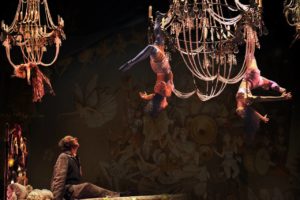
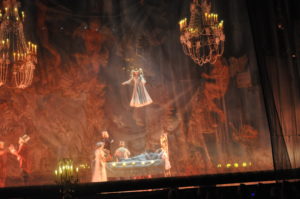


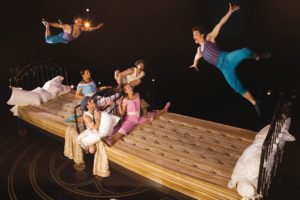


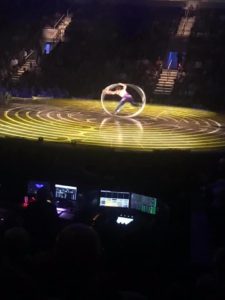

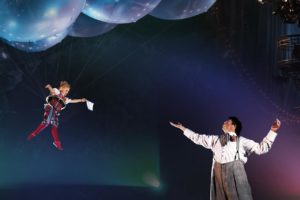
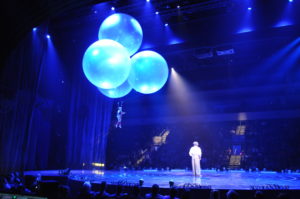
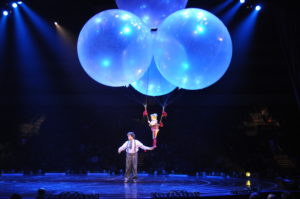

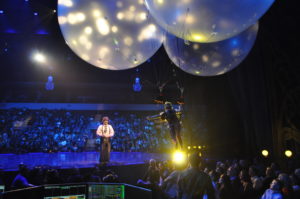
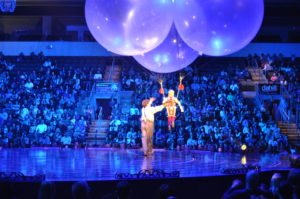
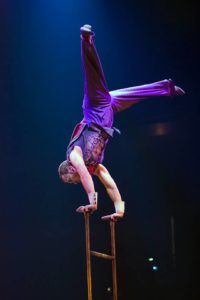
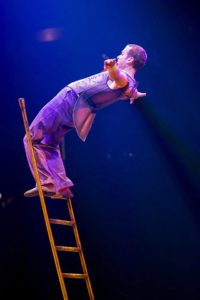

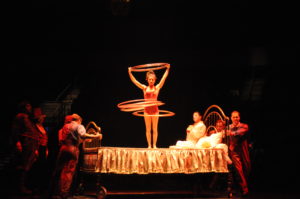
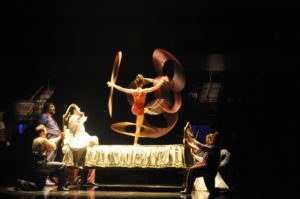
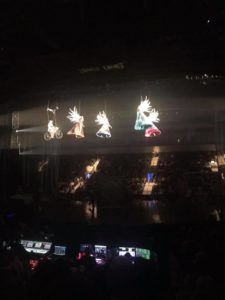

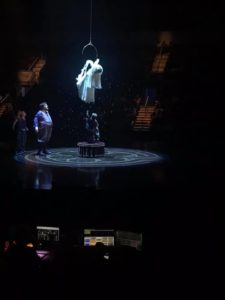
Comments